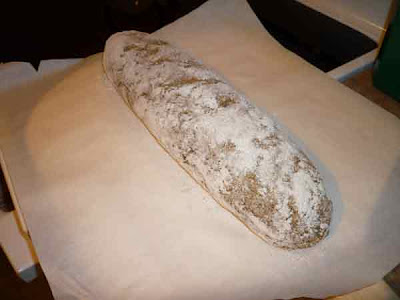Ojakangas' 100% Rye Bread
The other day I mentioned that I was interested in making Beatrice Ojakangas' 100% Rye Bread, from her book, "Great Whole Grain Breads". She writes,
"Only one yeast bread in this book is totally without wheat flour—that one is made with 100 percent rye flour. To make this rye bread, you must provide long souring and rising periods to develop both the gluten and the flavor of rye. Rye flour rather quickly produces a pleasantly sour flavor, and 100 percent rye bread has a close, heavy texture, but should not be doughy."I love rye bread. I have always found the dough to be very sticky, however. After making the big hydration mistake on the last 'Transitional' loaf the other day, though, I think I've relaxed a bit about the stickiness of doughs. If I can handle that kind of stickiness, I can handle the stickiness of a rye dough. And this particular loaf looked very interesting: no anise or fennel or caraway, just rye, and more rye (and a bit of salt, yeast and corn syrup). I had the ingredients: I had purchased some organic rye berries a couple of months ago, and hadn't yet found a use for them. This was my chance.
Here we have the ingredients. The rye kernels are cracked open in a food processor, then boiled for 45 minutes.
I divided my dark rye flour into three containers, because of the interesting way that it will be added. The first mixture is with the middle container, 2 cups of rye flour. It is to be mixed with the warm, boiled, cracked rye kernels and yeast. The foamy yeast take to this rye quickly, and in 30 minutes it rises substantially.
Reinhart, in one of his first books, 'Brother Juniper's Bread Book: Slow Rise as Method and Metaphor', talks about what might go wrong if you give some dough too much yeast, or if there is too much sugar in the dough. Essentially the yeast exhaust themselves, eat everything in sight, and by the time you toss it in the oven, they are all tired out, and there is no more rise.
This recipe gets around this by adding more flour to feed the yeast at a certain mid-way point. The yeast are given 30 minutes the first time, with lots of sweet corn syrup. Then, when you add more flour, they are given 2 1/2-3 hours to make the loaf big and airy (at least, as airy as rye can be).
This is the dough when the final salt and flour have been added and mixed:
I set the clock to ring after 2 1/2 hours, and woke up to find it hadn't changed all that much. Rather than bake the loaf just then (I was tired, it was about 0130), I let it go a bit longer. I was wondering if I should refrigerate it, but there are still a lot of leftovers from Easter, so I didn't think there was room in the fridge. I left it out on the counter.
Around 0400 the dog got me up due to an impending thunderstorm, the first of the season, and now sleepless I decided to finish making this bread. I poured the dough out as the recipe called for, on a floured surface to shape it. I wish now that I hadn't shaped it. The dough came out a lot airier and light than I thought it would. I wonder if I had put it in a banneton for the previous stage, if it might have retained its shape better for baking?
I shaped a loaf, and gave it about 30 more minutes. It felt like it was going to hold its shape.
However, before baking, the gluten sort of just came undone in it, and it flattened out. I should have used a couche. No need to score the loaf -- it has already pulled itself apart from gravity.
And of course, there was very little oven rise.
So I have a nice 100% rye flatbread.
It does taste interesting, however -- I think that the boiled rye kernels give the taste an interesting sour flavour, which is kind of surprising since the bread came together fairly quickly (compared to the long fermentation of Reinhart's breads, for example). Perhaps the bread would have benefited from just such a longer fermentation, who knows? It might also have benefited from a longer time in a hotter oven. The crumb still feels quite moist. I think that I will back the salt off by half, next time. Or change the way it is incorporated into the dough.
Notes to Myself:
- Use a couche to buttress rye breads and keep them from spreading sideways.
- Don't overproof rye dough. It won't rise double quite like a wheat dough, despite what the recipe says.
- Next time you try this recipe, try putting the dough in a well-floured banneton for the second rise and forget the shaping and proofing, and see if the dough retains its shape better for the oven.














No comments:
Post a Comment